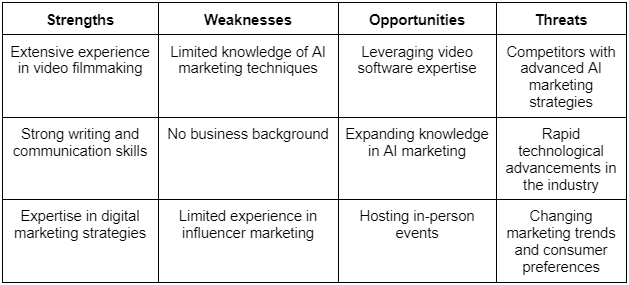Marketing Department Structure Guide: 14 Tips Leaders Need for Results

- Incorporate diverse perspectives in marketing strategy sessions to foster innovative ideas using tools like Miro, Mural, or Zoom.
- Regularly identify and address gaps in your digital strategy through in-depth analysis, competition assessment, and customer feedback.
- Focus on your marketing department's core strengths with a SWOT analysis to prioritize effective strategies.
- Establish specific KPI targets for your marketing department to improve decision-making and growth focus.
- Create a system for tracking KPIs with tools like Google Sheets or Analytics to ensure accurate progress monitoring.
There are plenty of ways to improve your marketing strategy and department. You could hire new talent, encourage team members to speak more openly, settle on a single source of truth, experiment better, and facilitate more collaboration.
These marketing suggestions have truths within themselves, and we support them. But they are apparent, non-specific, and known by every one of your competitors.
If you want to improve your marketing department and its strategies, it's vital to detail the exact steps, tools, and frameworks to change how your team works, thinks, and behaves. The following marketing tips highlight ways our team of marketing industry veterans has helped improve dozens of marketing strategies and departments for B2B companies across diverse industries and verticals.
Curious about immediately tapping into a team of marketing industry veterans to help you improve your marketing? Learn more about our company as well as our fractional marketing department services.
1. Include Multiple Stakeholders in Your Marketing Strategy Sessions
Marketing strategies thrive when diverse perspectives and expertise come together. Different views can challenge conventional thinking and lead to marketing strategies that disrupt your industry.
Involve stakeholders from different departments in your strategy sessions, especially from customer-facing roles, as they are the most suited to challenge your assumptions of who you market to. You can’t anticipate how you’ll innovate unless you open the space for ideas to clash and emerge.
While collaboration is crucial, finding a balance between inclusivity and practicality is essential. Too many people in one brainstorming session can hinder meaningful discussions and decision-making. At O8, we usually keep that number lower than seven and increase only if needed.
You can use Miro or Mural, or Zoom to facilitate collaboration. These tools give you virtual whiteboards, sticky notes, and interactive tools that ignite creativity and allow real-time contributions from everyone involved.
2. Identify the Gaps in Your Digital Marketing Strategy
Identifying gaps in your strategy can help you devise a marketing plan to make it right. Some tweaks to how you work can lead to improvements that may appear small but have a great impact. It could be reducing your sales cycle from ten to nine steps or redefining your ICP and customer profiles. No matter what, these small adjustments can help unlock new avenues for revenue or improve existing ones so you can do the same in less time.
Here's how we (and you) can identify gaps within your marketing team:
- Perform an In-Depth Analysis of Your Marketing Campaigns: We use Google Analytics to review our campaigns and Hubspot for our messaging and marketing channels.
- Assess Your Competition: Yes, we spy too. You can evaluate your competitors' strategies and positions with tools like SEMrush or SimilarWeb.
- Seek Customer Feedback: This is a big one. You need customer input as they're the ones you're serving. Get on a platform like Survey Monkeys, and create a simple survey to gather insights on your marketing approach from your customer base.
- Evaluate Resource Allocation: What is going on and where? Assess how resources are allocated across marketing activities. Are you investing enough in content creation, advertising, or technology? Consider reallocating resources to areas that have the potential to drive better results.
Once you identify the gaps, determine which has the most significant impact on your marketing performance and create actionable plans to address them. After, implement, rinse, and repeat.
3. Double-Down On Your Core Strengths
Rather than getting mediocre results on unfamiliar projects, focus on your expertise and core strengths where you see success. This is not meant to contrast the idea of opening up a space for innovation, as it can be good to take risky bets while squeezing those that you know you'll win at.
To determine the strengths of your marketing department, you can run a SWOT (Strengths, Weaknesses, Opportunities, and Threats) analysis. It is a strategic planning method used to evaluate the internal and external factors that can impact the success of a business, project, or department. Here's how it works:
Strengths:
Identify what your marketing team does really well. Think about your brand reputation, expertise in specific marketing areas, talented team members, or unique technologies or resources you have.
Weaknesses:
Identify the internal factors that hinder your marketing department's effectiveness or competitive advantage. It could be limited resources, gaps in skills or knowledge, inefficient processes, or outdated tools.
Opportunities:
Look for external factors that could benefit your marketing efforts. This could include emerging trends, new technologies, or untapped customer segments with growth opportunities. Opportunities can also come from leveraging external strategies like influencer marketing and affiliate marketing to reach new potential customers and drive sales.
Threats:
Identify external factors that could pose challenges to your marketing success. This may include competition, changing consumer preferences, or economic factors impacting your business.
Here's an example of a SWOT analysis for a marketing department in a video software company.

Once you have completed the SWOT analysis, focus on leveraging your strengths. In the case of this example, it might make sense to leverage the filmmaking experience to create compelling marketing videos that competitors can’t replicate.
Scale Your Marketing, Without Overloading Your Team
Our fractional marketing experts ensure seamless alignment between sales and marketing, keeping your growth sustainable and your team effective.
4. Identify and Set KPI Targets
Setting specific targets for Key Performance Indicators (KPIs) in your marketing department is crucial for making focused decisions, driving growth, and getting the best results. With clear targets, your team can maintain direction, save resources, and understand the true impact of their marketing efforts.
Pick five to ten metrics you feel are most important to your business. More than ten, and you might overwhelm yourself or fall into analysis paralysis.
Once you decide what KPIs you will focus on, set targets for each. The target should represent a specific goal or objective that you aim to achieve within a defined timeframe. For example, if your KPI is "leads generated," your target could be to generate 10% more leads than the previous quarter.
You can look at this in whatever time frame makes the most sense for your business. It's important to remain flexible and adaptable in your approach, so you can change your focus if you determine that certain KPIs are not as vital as initially anticipated.
5. Create a Reporting System to Track Your KPIs

Suppose your marketing department is accurately tracking KPIs. In that case, you can easily gauge whether they're on track to achieve the targets or if adjustments are needed. Data-driven marketing like this helps you stay focused, motivated, and aligned with your overall marketing objectives.
To effectively track those KPIs, your team needs a reporting system. This doesn't have to be a "pretty" dashboard with all sorts of bells and whistles for this in the beginning. Having quick and accessible visibility into up-to-date data is the most important thing.
Your team can try Google Sheets to set up the KPI dashboard categories. Google Sheets can pull in data from web pages and databases to automate the reporting process. It's important to set everything from scratch, an avoidable situation with a tool such as Google Analytics.
Once you start digging into them, think of ways to improve your dashboard reports. Do it when the time asks for it. Getting a framework in place and developing it once you iron out the bugs is better.
6. Create Customer Personas
A customer persona document summarizes what makes your average customer tick—their desires, pain points, and motivation. Your team can use it to frame any customer-facing channels as a solution to your target customers’ challenges. This will make your messages more persuasive, compelling, and targeted.
Use platforms like Google Analytics, Meta’s Audience Insights, and SparkToro to help create personas and uncover behavioral and demographic patterns among your website visitors and social media followers.
Various sources will inform your personas:
- Customer interviews. These can help you understand the primary benefit they find in your product, alternatives they considered, and how they would feel if you disappeared.
- Employee interviews. Use these to learn about the existing customers that pay the most, the challenges they had before purchasing, and the decision-makers involved in the process.
- Analytics tools. Leverage Google Analytics, Meta’s Audience Insights, and other consumer analytics tools to find behavioral and demographic patterns among your website visitors and social media followers.
Combine these qualitative insights to create comprehensive personas. Your goal is to make each of these sources tell the same story.
7. Identify Internal Barriers
By removing internal obstacles in your processes, you can achieve better results from your marketing team. For instance, siloed communication between sales and marketing groups can impede sales handoffs and follow-ups, leading to missed opportunities and lower conversion rates. You can enhance your team's performance by closing these gaps.

When identifying internal barriers in your team's operations, search for patterns, anomalies, and signs of inefficiency. This could look like landing pages with a higher-than-average bounce rate or gaps in your follow-up process
After identifying your internal obstacles, it is important to devise an action plan. This plan will serve as a guide to help overcome those barriers. By outlining specific steps and tasks, you'll have a clear and organized strategy to tackle your identified issues.
You can easily create an action plan for your marketing department in five steps:
- Prioritize: Assess the impact of each barrier in front of marketing goals and decide which ones demand immediate attention. Focus on the ones that have the potential to make the most significant impact on your results.
- Set goals: Identify and define measurable goals you want to achieve by eliminating these barriers. Ambiguity has no place in your action plan.
- Break it down: Divide your action plan into smaller tasks or milestones to make it more manageable. This way, you can conquer them individually and keep the momentum going.
- Allocate resources: Determine the time, marketing budget, and personnel you need to tackle the barriers effectively. Resources should match the level of priority you set.
- Experiment and adapt: Be open to trying new approaches and adjust your marketing tactic if needed. What gets you to one point might not get you to the next one.
Get Your Customized Marketing Department Structure
Our specialists design tailored strategies to fit your unique business needs. Schedule a free consultation today and see immediate improvements in your team's performance.
8. Look for Opportunities To Be More Efficient
SnapLogic says around 90% of employees deal with repetitive and boring tasks. This lack of enthusiasm and engagement can cause inefficiencies in your operations and day-to-day work. Performing regular efficiency audits help your team identify opportunities to work better and faster.
If you use project management tools, go to the reports section and look for outside of average time spent on tasks. Then discuss with your team to understand what’s been happening and how it could improve. Teams without project management tools can jump straight into asking employees about activities requiring time, effort, and resources.
We swear by HubSpot Workflows for streamlining repetitive tasks and manual processes. It saves us time by automating routine tasks, such as sending follow-up emails, updating contact information, or assigning tasks to team members. Your team can use the freed-up time to focus on higher-priority tasks that no tool can do.
9. Upscale Talent
Prioritize continuous learning and professional development. Keeping a dynamic and pleasantly challenging work environment motivates any marketer or team member to grow within your company instead of doing it elsewhere.

Provide your team members with training programs, workshops, or access to educational resources that will equip them with the latest marketing tactics and techniques. To determine the subjects for these resources, we suggest conducting a skills gap analysis within your marketing team. This helps you tailor the educational resources to address identified gaps, ensuring that your team receives valuable and relevant training. This, in turn, will help them excel in their roles and contribute to a more successful marketing department.
Alternatively, you can foster opportunities for cross-team collaboration where team members can learn from each other. This can include shadowing, collaborating on projects, or co-leading events. If you don’t have the time to recruit top talent, you can work with a partner like our digital marketing agency to fill some of those gaps.
10. Develop a Performance Mindset Throughout Your Organization
An effective marketing strategy requires a company-wide commitment to performance-driven culture.
Consider implementing the Lean Methodology in your organization to help facilitate this process. The Lean Methodology optimizes processes and minimizes waste to enhance efficiency and customer satisfaction.
One of the key principles of the Lean Methodology is encouraging feedback from team members of different departments. When people are hesitant to share their ideas, chances of innovation and people’s willingness to collaborate between teams go down. The customer support team might have some ideas for the marketing team that could both improve their message to prospects and reduces the amount of support needed from the support team after they close a sale; create so they can share them.
11. Create Your Marketing Funnel
The marketing funnel concept refers to the steps a customer takes from the moment they become aware of your business to the point of making a purchase. A marketing funnel allows your department to understand and analyze customer behavior at each stage. This way, your team can implement more targeted and personalized marketing strategies.
While all of the steps we described are entire guides in themselves, creating a marketing funnel would be the lengthiest of all. For now, focus on the following:
- Classify existing marketing strategies by stage of the funnel: attract, inform, convert, or engage.
- Look for qualitative data (e.g., ask employees) and quantitative data (e.g., check HubSpot) that you can use to evaluate their performance.
- Measure their success based on the stage of the funnel they are trying to impact.
For example, let’s say you chose LinkedIn ads as your method to convert strangers into prospects. You look at the data and see they have brought 1,000 profile views but no leads. In that case, you need to reevaluate how you run LinkedIn ads or if they are the right way to bring leads.
12. Balance Short-Term and Long-Term Marketing Campaigns
Marketing campaigns positioned toward short-term results have their place. You can quickly move the needle if your team can attach a product or idea to trends and events.

But as the name suggests, these campaigns can be unreliable and highly influenced by factors outside your control. If you were to rely on them exclusively, you would have to anticipate and jump from trend to trend.
Longer-term campaigns require more time and effort to set up and build, but their results tend to extend over longer periods more sustainably. Take this 2020 project. Intending to increase the number of inbound leads a particular business received, we realized that while paid ads could have earned some quick leads, we preferred to invest in a more long-term initiative: content marketing. We wrote, optimized, and distributed blog posts. While results took more than a few weeks, the business went from receiving 5,000 monthly visitors to 15,000, adding hundreds of leads yearly.
It's recommended to include a variety of marketing campaign types in your marketing strategy. Short-term campaigns can bring in revenue to support long-term initiatives. For example, you could run a temporary sale for an eCommerce business to generate quick sales and income. You can then use the profits to invest in your long-term goals to build brand awareness, increase traffic, and foster brand loyalty among customers.
The revenue from your long-term initiatives is the lifebuoy for your short-term ones. It gives you the confidence to experiment with new short-term initiatives without fear of starting from scratch.
13. Make Sure You Have the Right Tools in Place
It is important for your marketing department to have access to the right tools to be successful. Without the proper tools, they may have to resort to manual and time-consuming approaches, which could ultimately waste valuable time and resources.
Access to innovative tools enables your team to stay agile, experiment with new marketing techniques, and adapt to the ever-changing marketing landscape.
A lot of these tools fall into one of these categories:
- Chatbots
- Analytics
- Social media scheduling tools
- Email and marketing automation
- Webinars
- CRM system
- Heatmaps
Of course, tools require a financial investment. But most monthly cost is less than the daily rate of your average employee. Consider that and the time saved that these employees can now spend on more high-value tasks, and it’s hard to come up with an objection to buying these.
14. Harnessing AI for Marketing Teams
Incorporating AI into your marketing strategies can revolutionize how your team operates, driving efficiency and effectiveness. Here are some key advantages of AI for marketing teams:
- Streamlined Operations: AI can handle a multitude of routine tasks, from scheduling social media posts to managing email campaigns. This frees up your team to focus on more strategic and creative pursuits. By automating these repetitive tasks, AI allows for a more streamlined workflow and reduces the time spent on manual processes.
- Enhanced Personalization: One of AI's standout capabilities is its ability to analyze vast amounts of data quickly and accurately. This analysis can provide deep insights into customer behavior and preferences, enabling highly personalized marketing efforts. AI can help tailor content, offers, and communications to individual customers, enhancing their overall experience and increasing engagement.
- Improved Decision-Making: AI tools can process and analyze data in real-time, offering valuable insights that inform decision-making. Predictive analytics, for example, can forecast customer behavior and market trends, allowing your team to make more informed and proactive decisions. AI also enables more precise targeting and segmentation, ensuring that your marketing effort reaches the right audience.
- Cost Efficiency: By automating tasks and optimizing processes, AI can significantly reduce operational costs. Marketing teams can achieve more with fewer resources, making AI a cost-effective solution. This efficiency allows for better allocation of budgets towards high-impact activities, ultimately improving ROI.
- Increased Agility: Marketing landscapes are dynamic and ever-changing. AI provides the agility needed to adapt quickly to new trends and challenges. Real-time data analysis and automation allow marketing teams to respond faster and more accurately to market shifts, ensuring they stay ahead of the competition.
- Creativity and Innovation: While AI handles the heavy lifting of data and automation, marketers can focus on creativity and innovation. AI provides the tools and insights needed to develop unique and compelling campaigns. By leveraging AI's capabilities, marketing teams can push the boundaries of creativity and deliver more impactful and memorable marketing experiences.
Incorporating AI into your marketing strategy offers numerous advantages that can transform your team's efficiency, effectiveness, and overall success. By harnessing the power of AI, you can achieve new levels of personalization, decision-making, cost efficiency, agility, and creativity.
Lessons Learned from Marketing Department Optimization
Now, with a complete picture of what facilitating a marketing transformation looks like, let's dive into several key takeaways we've seen repeatedly in our work.
Marketing Isn't a Separate Process
The best marketing strategies incorporate every key department, including sales, product engineering, technical support, marketing, and human resources.
Product marketing plays a crucial role in bridging the gap between product development and customer needs. By working closely with sales, product engineering, technical support, and human resources, you can ensure that your marketing efforts align with the customer's journey and address their most pressing needs.
Treating your marketing as separate can lead to mixed customer messaging, poor out-of-the-box experiences, and product development that misses the most-requested features.
Don't Overthink Your Marketing
Your team might want to target every possible inbound marketing channel — Search engine optimization (SEO), search engine marketing (SEM), social media marketing, email marketing, partnerships, etc. Trying to do them all at once usually ends up with none working as well as they could. Start simple and get one channel working before you add another. Spend some time optimizing a specific strategy or approach to maximize ROI. That will scale back the time spent on it while rolling out the next channel.
Market Research Is an Ongoing Process
A successful marketing strategy is built on a foundation of data-driven insights that accurately reflect your target market. Regularly conducting market research and updating customer personas ensures your campaigns align with the evolving needs of your target audience.
Creating customer personas and conducting market research is not a one-and-done task. Markets are dynamic, and customer needs can evolve over time. To ensure effective marketing, make market research an ongoing process. Use the data you gather from your marketing funnel to identify areas showing a downward trend and dig into those more. This iterative approach lets your team stay attuned to a target audience's changing preferences and adapt strategies accordingly.
Systematize Your Processes
Turnover is inevitable. You will lose staff at some point or another. Having documented systems in place for all your ongoing processes and workflows will make it easier for someone else to take over or train a new employee when the time comes. Systemization is useful even if you're a small business and outsource your marketing work to an agency. A good agency can work within your existing processes and suggest ways to improve them. Having good documentation in place will make it easier for everyone involved.
Work With a Marketing Team That Ticks All These Boxes
When your team is knee-deep in the day-to-day marketing operations, it's natural to focus on the immediate tasks and challenges. This narrow focus can sometimes prevent them from seeing the bigger picture and identifying underlying issues or opportunities.
The team at O8 has had the opportunity to interact with hundreds of marketing departments. We've repeatedly seen how neglecting any of these activities can prevent or diminish results. However, it's also true that you can't magically show up tomorrow at work and change everything in tandem.
You can overcome your challenges by working with O8. We've helped hundreds of companies implement these steps. More importantly, they are a core part of our fractional marketing team.
Instead of spending months hiring, screening, and training full-time employees on these steps, fill up every marketing position with veterans who live and breathe these steps for half the cost.
Book a call with us or fill out a form to learn how we can bring measurable growth to your company.








